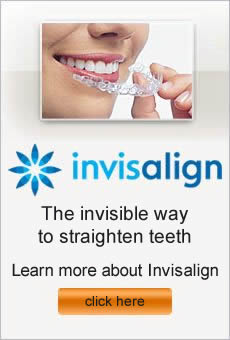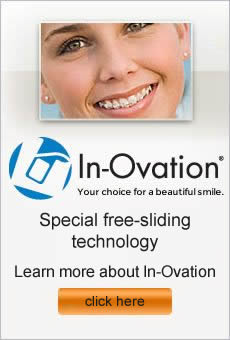One of the greatest benefits of Invisalign is the minimal impact it has on your everyday life. You should wear your Invisalign at all times, except when eating, brushing and flossing. Because the aligners are exceptionally comfortable, it should be easy to wear them for the recommended 20 to 22 hours per day.
Taking care of Invisalign aligners is also very simple. By following these guidelines, you will help to ensure a successful Invisalign treatment:
- The best way to clean your aligners is to use the Invisalign cleaning kit. If your kit is not accessible, another effective method is to brush and rinse the aligners with warm water. Every time you brush your teeth, you should also clean your aligners.
- Always rinse your aligners thoroughly before replacing them in your mouth.
- There are no food restrictions with Invisalign. However, the aligners must always be removed when eating.
- To avoid permanent damage to your aligners, do not place in boiling water or leave them anywhere warmer than your mouth.
- Never use denture cleaner or soak them in alcohol or bleach.
- When not being worn, store your aligners in the retainer case that was provided by your dental professional.
- Do not chew gum or smoke with aligners in your mouth.
- Do not remove your aligners at night.
- When drinking any beverage other than water, use a straw.
- If you play a contact sport that necessitates the use of a protective mouth guard, simply remove your aligners and replace with the protective appliance.
Remember, Invisalign only works when you are wearing them. If you lose your aligner or miss wearing it for several days, contact your orthodontist in Sherman Oaks right away to receive advice on how to proceed.
The American Association of Orthodontics and The American Dental Association recommend that children see an orthodontist for evaluation by their 7th birthday. Some kids are thrilled at the prospect of getting braces, and some are scared and hesitant. No matter where your child falls on the spectrum, the first visit to the orthodontist can determine their attitude towards future orthodontic visits. Here are some tips you should keep in mind when preparing your child for their first visit to the orthodontist:
- Explain the importance of taking care of their smile. Besides just having straight teeth, it is vital for kids to understand early that oral health is extremely important and plays a role in their overall health.
- Make your child aware of what to expect at their initial consultation. Knowing what happens will make the prospect of the visit less scary. If you are unsure about what the visit will entail, contact your orthodontist’s office for any questions you may have.
- Set realistic expectations for the first appointment. Some kids may be disappointed to learn they won’t be walking out of their first visit with a full set of braces. Make sure they understand the orthodontist will take good care of them and begin their braces at the perfect time.
- Maintain a positive attitude about the entire process. Be relaxed and don’t use words like “scary” or “hurt” and don’t share orthodontics horror stories. Focus on the result and the benefits of having a straight, beautiful smile.
To create a smile that lasts a lifetime, your child needs teeth that are straight and jaws that are aligned correctly. Good dental health begins early. By positively preparing your child at a young age for orthodontic care, you are setting the stage for a lifetime of good oral health and beautiful smiles.
One specialty field of dentistry is orthodontics, whose purpose is to correct teeth that are misaligned or crooked so that your smile is improved. There are a variety to methods and tools that may be employed in the orthodontic process, with the most common being braces. It depends on your specific oral issues, and sometimes teeth must be extracted as part of the treatment plan. Results are usually achieved in two years or less for the average orthodontic patient.
There are many reasons that people turn to orthodontics for help. Imperfect smiles may be a result of genetics, trauma, chronic thumb sucking, tongue thrusting, or other factors. No matter the cause, people whose teeth and mouth have failed to develop ideally are often candidates for orthodontic treatment. This is especially true since an embarrassing smile can lower self-esteem and cause patients to go through life hiding their smiles.
Some of the most common reasons that orthodontists recommend braces or other treatments include:
- Crowding – permanent teeth may grow abnormally and end up overcrowding other teeth in the mouth
- Protruding teeth – teeth that stick out past the others, often referred to as buck teeth, occur especially in the upper teeth
- Overbite or underbite – these bite issues are when either the lower teeth are excessively covered by the upper ones, or vice versa
- Open bite – often related to prolonged thumb sucking, the lower and upper teeth may not meet together properly
- Asymmetrical teeth – the upper and lower teeth are not aligned correctly, giving a crooked appearance to the smile
- Impacted teeth – adult teeth do not erupt properly and grow in the wrong position under the gums
If you or a loved one have any of these issues or others related to your smile, schedule a consultation with an orthodontist for an evaluation. Most orthodontics recommend seeing patients as early as age 7, because early intervention can sometimes help avoid more extensive or longer treatment later. The teen years are common ages for treatment, but adult orthodontics is very popular as well.
If you are considering straightening your teeth, you may be looking into various orthodontic options. One treatment for correcting a crooked or overcrowded smile is Invisalign. Invisalign uses a clear set of BPA-free plastic trays called aligners to straighten teeth without the metal and brackets associated with traditional braces. The following are some common questions you may have about Invisalign:
- Who is a good candidate for Invisalign? Patients who have healthy teeth and gums are usually good candidates for Invisalign. Adults, teens, and older children whose teeth, including their second molars, have grown in completely can be considered for treatment with Invisalign.
- What kinds of problems can Invisalign correct? Invisalign corrects the same dental problems as traditional braces, including simple to severe overcrowding, gaps, crossbite, overbite, and underbite.
- How long does Invisalign treatment take to complete? Most Invisalign cases are completed within one year. However, the exact amount of treatment time is dependent on your individual situation.
- How long do I have to wear the aligners each day? You will remove the Invisalign aligners when you eat, drink, or clean your teeth. Otherwise, the aligners should be worn for a recommended 22 hours per day to achieve the desired results.
- Are there food restrictions with Invisalign? Because you remove the aligners when you eat, there are no limitations to the types of food you can eat while undergoing treatment.
- Are retainers necessary with Invisalign? Once you have completed treatment, you will need to wear retainers while you sleep to ensure your teeth stay perfectly straight.
To determine if Invisalign is a viable option for your specific orthodontic needs, you should schedule a consultation with an Invisalign trained dental professional where you can ask additional questions specific to your case. No matter what stage of your life, Invisalign offers a comfortable, state-of-the-art approach to beautifying and improving the quality of your smile.
If you have had braces and are now wearing a retainer, you won’t want to lose it! Wearing your retainer ensures that the hard work and diligence you have endured during braces pays off for the rest of your life. The convenience of a retainer means that now you’re able to take it out as recommended by your orthodontist.
Whether it’s recommended that you wear your retainer at all times except for during meals or snacks, or whether you’re to wear it only at night, there are going to be times when you take your retainer out of your mouth, opening up the possibility that the retainer is lost or damaged. Follow some basic tips to ensure that your retainer never needs replacement or repair and that your teeth continue to look and to function as well as they did the day your braces came off.
- Get a bright retainer case. A bright case will be far less likely to be overlooked. You may feel a little conspicuous, but you won’t ever walk away from the case without noticing it. Label the case so that if you do happen to leave it, someone can return it to you.
- If you leave your retainer off for periods of time, keep the case in one spot. Whether that spot is your sink, your nightstand, your purse, backpack or locker, habitual storage is the key to keeping your retainer safe.
- Never, ever wrap your retainer in a napkin. It is too likely to be grabbed and discarded as trash. If you remove your retainer at lunch, keep the case handy in your pocket, purse or backpack. You know where it is, it’s safe and tucked away. “If it’s not in your face, it’s in the case” should become your motto.
- Wear your retainer when your orthodontist has instructed. When it’s in your mouth, you won’t lose track of it! Wearing your retainer makes your time in braces mean a lifetime of beautiful teeth that function as they should, providing you a base for good oral and general health.
Follow these steps to keep your retainer a part of your oral habits for life.
Metal braces used to go hand-in-hand with teenage years. Those awkward years were made so much worse with the taunts of “metal mouth” or “brace face.” Today, if your teen is dreading those comments, there are alternatives, particularly Invisalign Teen
Has your teen been told that braces are a necessity? Is he or she fearful of time spent in metal braces? Invisalign could be the solution, providing an “invisible” way to straighten and align crooked teeth.
Not all teens are suited for treatment with Invisalign. The aligners must be worn diligently, up to 22 hours a day, in order to work properly. Teens may be tempted to remove them more often than recommended, leading to far longer treatment time or ineffectual treatment.
Changes in Invisalign treatment are addressing the specific needs of teens with solutions like the blue dot wear indicator, which allows dentists and parents to determine if the teen is wearing the aligner the recommended amount of time.
Power ridges provide the maximum force necessary to exact complex movements in the mouth, including the movement of tooth roots. Because some teens are still in the process of having their teeth erupt, Invisalign aligners can feature eruption tabs or other design elements for teeth that are still in the process of erupting.
Benefits like these allow Invisalign to cater to a teen’s specific orthodontic needs while still providing all of the things that make Invisalign aligners so popular with patients of all ages.
Invisalign makes it possible to remove the plastic aligners while teens are eating or cleaning their teeth. Metal braces can trap unsightly bits of food, leading to a teen being self-conscious. Oral hygiene habits remain far easier with Invisalign than with traditional metal braces. Flossing takes place normally, while flossing with traditional metal braces is very challenging.
If you have questions regarding whether or not Invisalign or traditional metal braces are right for your individual teen, talk to a skilled orthodontist today. Your orthodontist will determine if Invisalign will be the most effective treatment to address your teen’s orthodontic needs.



